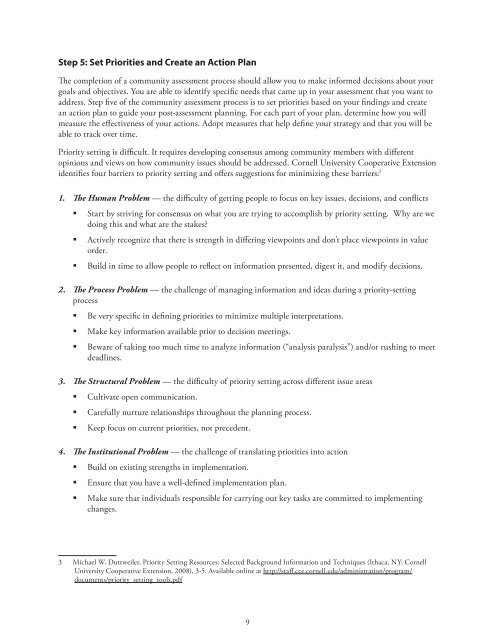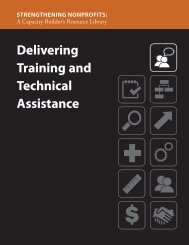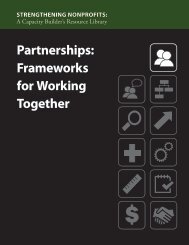Conducting a Community Assessment - Strengthening Nonprofits
Conducting a Community Assessment - Strengthening Nonprofits
Conducting a Community Assessment - Strengthening Nonprofits
You also want an ePaper? Increase the reach of your titles
YUMPU automatically turns print PDFs into web optimized ePapers that Google loves.
Step 5: Set Priorities and Create an Action PlanThe completion of a community assessment process should allow you to make informed decisions about yourgoals and objectives. You are able to identify specific needs that came up in your assessment that you want toaddress. Step five of the community assessment process is to set priorities based on your findings and createan action plan to guide your post-assessment planning. For each part of your plan, determine how you willmeasure the effectiveness of your actions. Adopt measures that help define your strategy and that you will beable to track over time.Priority setting is difficult. It requires developing consensus among community members with differentopinions and views on how community issues should be addressed. Cornell University Cooperative Extensionidentifies four barriers to priority setting and offers suggestions for minimizing these barriers: 1 31. The Human Problem — the difficulty of getting people to focus on key issues, decisions, and conflicts• Start by striving for consensus on what you are trying to accomplish by priority setting. Why are wedoing this and what are the stakes?• Actively recognize that there is strength in differing viewpoints and don’t place viewpoints in valueorder.• Build in time to allow people to reflect on information presented, digest it, and modify decisions.2. The Process Problem — the challenge of managing information and ideas during a priority-settingprocess• Be very specific in defining priorities to minimize multiple interpretations.• Make key information available prior to decision meetings.• Beware of taking too much time to analyze information (“analysis paralysis”) and/or rushing to meetdeadlines.3. The Structural Problem — the difficulty of priority setting across different issue areas• Cultivate open communication.• Carefully nurture relationships throughout the planning process.• Keep focus on current priorities, not precedent.4. The Institutional Problem — the challenge of translating priorities into action• Build on existing strengths in implementation.• Ensure that you have a well-defined implementation plan.• Make sure that individuals responsible for carrying out key tasks are committed to implementingchanges.3 Michael W. Duttweiler, Priority Setting Resources: Selected Background Information and Techniques (Ithaca, NY: CornellUniversity Cooperative Extension, 2008), 3-5. Available online at http://staff.cce.cornell.edu/administration/program/documents/priority_setting_tools.pdf9






